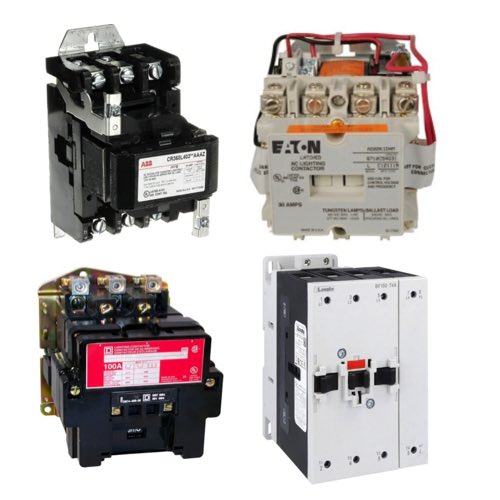All Starter Contactors

Starter contactors are essential components in motor control systems, designed to manage the starting and stopping of electric motors while providing protection against overloads and electrical faults. They operate by switching electrical power to the motor, ensuring smooth and reliable motor function. Starter contactors are used across various industries such as manufacturing, HVAC, and automation, where precise motor control is crucial for efficient operations.
These contactors are available in a range of sizes and ratings to accommodate different motor capacities and power requirements. They can be configured for both AC and DC applications and come in various types, including direct-on-line (DOL), reversing, and non-reversing models, depending on the specific needs of the system. In addition to controlling the motor, many starter contactors are equipped with overload protection mechanisms, such as thermal relays, to safeguard motors from excessive currents and overheating.
More Information about Starter Contactors
You can find motor starter contactors in both IEC and NEMA configurations. They have both reversing and non-reversing models. They come in a wide range of sizes and are used in a wide range of applications. However, they aren't just used in heavy-duty industrial applications; they aren't just used in mining and metallurgical applications; and they aren't just used in oil and gas applications. They are essential for anything you would consider a "reliable" or "rugged" installation where you need to control a motor reliably and keep it cool while it does whatever it is it needs to do.
Motor Control Basics
Motor control allows operational control of electrical motors in various environments.
Motor control circuits provide a safe way to operate electrical motors. Back when motor control circuits were in their infancy, it would have been common to see a simple disconnect switch that would be used to turn on and off a motor. Depending on the size of the motor and how much voltage was required, operating this disconnect would have been dangerous, with a very high possibility of arcing or electrocution. Not to mention that when the disconnect was actuated, the large amount of inrush current would have damaged the motor over time.
In today's motor control circuits, there are a few common pieces of hardware.
A circuit breaker is used to protect the motor and any hardware downstream. A contactor and an overload relay are connected together and function in tandem to allow for remote and safe operation of the motor. The contactor functions much like a relay, allowing for a smaller electrical circuit to remotely close the motor contacts, starting the motor. The overload relay is designed to protect the motor in the case of a prolonged overcurrent event. These two devices are wired in series, so that if the overload relay detects an overcurrent event, the contactor will open the motor contacts, shutting off power to the motor.
The other two most common types of motor control hardware are a soft starter and a Variable Frequency Drive (VFD).
Both of these devices function in a similar way to the motor circuit with some added functions. The soft starter is designed to reduce large inrush current to the motor upon startup. This “soft starting” of the motor will prolong its life and allow for safer operation. The VFD performs the soft start functions, but also allows for speed control of the motor. This speed control is critical in many different environments and has made VFDs one of the most common and safe to use motor control circuits today.

